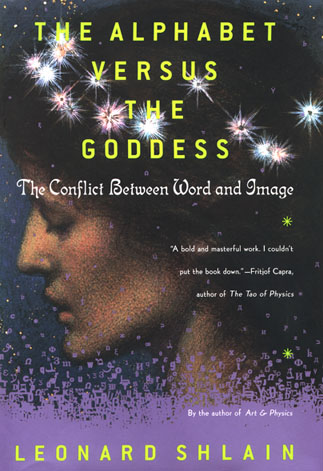The Alphabet Vs. the Goddess
I brought this book up briefly in Eleven's comment-section yesterday but I figured I'd talk about it a bit more specifically with regard to the main focus of the book (rather than focusing on one of its more minor topics).
I'm... intrigued by this book. Intrigued is just one adjective I can use to describe it though. I also occasionally find myself annoyed or frustrated or wowed or a billion other worthy adjectives. But regardless, it's an interesting read.

The basic premise is summed up in the final paragraph of the intro:
"Goddess worship, feminine values, and women's power depend on the ubiquity of the image. God worship, masculine values, and men's domination of women are bound to the written word. Word and image, like masculine and feminine, are complementary opposites. Whenever a culture elevates the written word at the expense of the image, patriarchy dominates. When the importance of the image supersedes the written word, feminine values and egalitarianism flourish." (7)
Basically, what Shlain contends is that with the dawning of the alphabet, an appreciation and use of images as a communicative form diminished. And in turn, we moved away from a goddess-worshipping culture to a patriarchal culture that began to worship male, imageless gods. Ultimately Shlain is attempting to prove that "writing subliminally fosters a patriarchal outlook" (1) because writing and understanding the alphabet require a finetuned usage of the left-brain (sequence, analysis, and abstraction). The left-brain and its qualities are culturally associated with the "masculine," and thus, he believes that it was this transition over to a literate culture that fostered patriarchy and male-dominated religion.
The premise itself is an interesting one, but what I find myself most resistant to in the book is the fact that he seems reliant on dichotomies to prove his point--the chapters are set up in terms of dichotomies (ex. "Birth/Death" is the title of one) and many of the points he makes are reliant upon us accepting and agreeing with the black & white dichotomy of male/female and masculine/feminine. I think this right away undercuts his viewpoint (despite the fact that he keeps trying to reassure us that this dichotomy is one that is established by society and not solely by him) because many people don't believe that such a black & white dichotomy exists in terms of gender, that gender is more fluid and malleable.
Anyways, I am about halfway through this book right now, and I do recommend it (despite the fact that Shlain gets really annoying at times). It's a fairly quick read with fairly short chapters which is nice because it doesn't allow you to get too bored with a topic--when you're right about to throw the book down, it's time for a new chapter... If you're looking for something to throw on your summer reading list, this is a decent option.
(Oh, and feel free--as always--to give your own two-cents about this topic in my comments section.)
-------


0 Comments:
Post a Comment
Subscribe to Post Comments [Atom]
<< Home